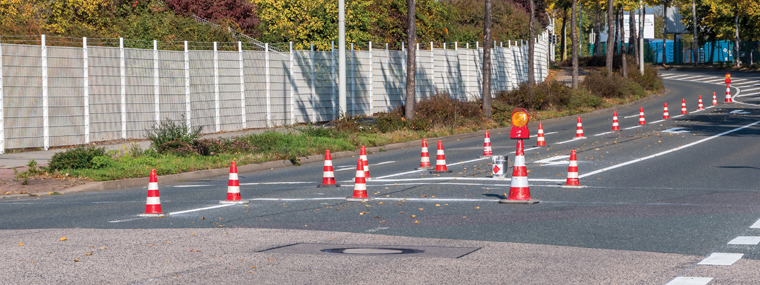
Your Roads Need Therapy!
The Science Behind Maltene Replacement Therapy
By Chris Evers / Published March 2019

Please don’t take offense, but you need to get your roads into therapy! That’s right; just like people, even roads that look youthful and normal should seriously consider getting some help. It shouldn’t surprise us that what may look healthy and great on the outside could be hiding some deterioration which, if left unchecked, will mean big problems down the road. This article is meant to help HOA board members, property managers, and residents alike think twice about whether they have a solid, long-term care plan for their community’s roads. Without such a plan, “asphalt hospice” could be in your future sooner than you think!
The truth of the matter is…
Even though you can’t see it, your road is slowly being cooked to death by the ball of fire in the sky. Of course, most of us are in Florida because of the sun. Still, you wouldn’t go to the beach all day without wearing sunscreen, would you? The American Cancer Society estimates about 3.3 million people are diagnosed with skin cancer each year in the US, and about 15,000 of those die. The vast majority of these people seek medical attention and require surgery to remove the cancer. I doubt there is a single one of these folks who would now choose not to employ preventative treatments or therapies to combat skin cancer.
The Webster’s New World Dictionary defines therapy as the treatment of any physical or mental disorder by medical or physical means, usually excluding surgery. Preventative medicine is a great model for how we should look at any of our communities’ fixed assets, especially roads. Back to your skin for a second—when sunlight penetrates past the epidermis to the dermis layer, damage occurs to the collagen-producing fibroblast. Collagen plays a critical role rejuvenating our skin by repairing damage and keeping skin tight. Damage to our DNA can occur when radiation burns (that’s what a sunburn really is) caused by UV rays penetrating unprotected skin. Sunscreen protects the epidermis and dermis by adding UV protection to the surface of your skin, which prevents damage to the fibroblast and the DNA in the upper layer of skin cells. In fact, one of the hottest trends in skin therapy, collagen induction therapy, spurs collagen production in hopes of rejuvenating your skin.

Maltene-replacement technology requires the proper distribution of these four fractional components of maltenes to optimize roadway service life extension.
The Collagen of Asphalt—Maltenes
The surface of your asphalt roads burn just like your skin does when left with no protection. Asphalt is sensitive to the effects of UV radiation. In fact, that’s the biggest cause of road failure in Florida. The oxidation taking place on the asphalt surface over years of service means the asphalt loses its flexibility, becomes brittle, and cracks. There are two primary major components in asphalt cement, asphaltenes and maltenes. Understanding how these components react during the aging process is the most important aspect to the proper care of your community’s roads. The science behind this phenomenon is that under high temperatures the light ends (maltenes) in the asphalt fractions volatize and leave the road. That’s bad.
The maltenes, like collagen, are critical in maintaining a youthful appearance and long life for your roads. That’s because they are the only components in the road that are prone to deterioration. The rock in the asphalt pavement is relatively inert, as is the other primary component in asphalt binder, asphaltenes. That leaves only the maltenes. These little guys are highly volatile and reactive, and because of this, under long exposure to the sun they decide they have had enough and they split. On to the next life they float off to asphalt heaven. That’s bad because the maltenes are the life of the party in your road. The better we are at keeping them around, the longer the asphalt binder will perform at its peak level.
Maltene Replacement Therapy
The most popular therapy or pavement preservation method happens to be something that’s been around a long time that we have begun to call maltene replacement therapy. Asphalt rejuvenation can only be accomplished using maltene-based technology. Putting back the components in the binder that are lost to oxidation extends the life of the roadway and helps to maintain a tight asphalt pavement. Just like tight skin is good for both your youthful appearance and protecting the rest of your body from intrusion, tight asphalt keeps water from penetrating into the road base and doing damage. Asphalt rejuvenation is best applied to roads that are one to five years old and are still in good condition. Just as you wouldn’t wait until after you sunburn to put on sunscreen, don’t wait to treat your recently resurfaced roads with asphalt rejuvenation!
Chris Evers
Technical Representative for Pavement Technology Inc.
Chris Evers has served as a technical representative for Pavement Technology Inc. since 2011 and has been involved in the road building business since 1996. He is a past president of the APWA Florida Chapter and an active participant on its Legislative Affairs committee. He founded and continues to moderate the annual APWA International Public Works Director Roundtable and was also instrumental in founding the Florida Pavement Preservation Council. Chris is a popular pavement preservation educator/speaker throughout Florida and resides in Vero Beach. For more information on Pavement Technology, visit www.pavetechinc.com or contact Chris via info@pavetechinc.com.






